Boxer RCH 155 demonstrates MRSI and fire-on-the-move capabilities

Krauss-Maffei Wegmann (KMW) has showcased its latest iteration of the Boxer RCH 155 (remote-controlled howitzer) variant in front of an international audience in Germany. The Boxer 8×8 vehicle is made by ARTEC, a joint-venture between KMW and Rheinmetall. An unique feature of the design is the separation of the vehicle into two different modules: the drive module – containing the power pack, the drive train, the electrical power supply and the driver’s station – and the mission module, which contains all role and mission specific equipment.
The Artillery Gun Module
In case of the Boxer RCH 155, Krauss-Maffei Wegmann developed a new mission module to turn the Boxer into a self-propelled artillery gun. It is largely based on its existing Artillery Gun Module (AGM) concept, which KMW originally showcased back in 2004. The AGM is a fully-automated and remotely operated turret fitted with a Rheinmetall 155 mm L/52 rifled gun. This gun has a muzzle break and a 23 litre chamber and is fully compliant with the NATO Joint Ballistic Memorandum of Understanding (JBMOU). A small radar unit mounted above the barrel is used to measure the muzzle velocity analogous to the Panzerhaubitze 2000 self-propelled gun.

The AGM provides sufficient room to store 30 rounds of 155 mm main gun ammunition and 144 propellant charge modules in its autoloader system; all of them in a ready-to-fire configuration. Several hatches and a large rear door allow the crew to access the autoloader and internal systems in case of a malfunction, though restocking the ammunition load is possible via an external mechanism.
The Artillery Gun Module has a gun depression of -2.5° and a gun elevation of up to +65°. The turret can be rotated and fired along the full 360° azimuth. The current version of the system can reach a rate of fire of up to 9 rounds per minute, though this rate cannot be sustained for a longer period of time, as otherwise the barrel would overheat. The high rate of fire allows the AGM to conduct multiple round simultaneously impact (MRSI) firings with up to five rounds – the time frame between the impact of the first and the last projectile on the target is claimed to be just two seconds.
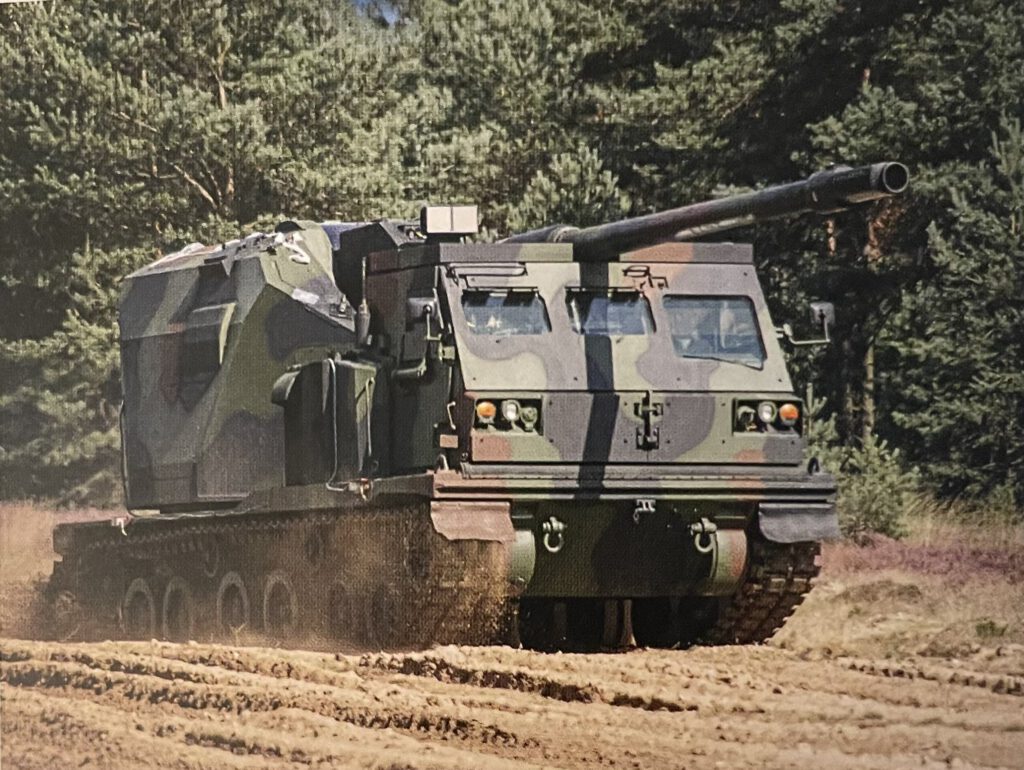
Originally the Artillery Gun Module was offered as stand-alone static turret as for campsite defence (the Dutch and German ISAF contingents utilized the Panzerhaubitze 2000 for protecting their bases in Afghanistan against attacks from the Taliban) and as a mobile version mounted on a modified M270 MRLS chassis. None of these two systems has been purchased yet.
Donar, the god of thunder
As the M270 chassis was old and not able to deliver the desired performance levels when burdened with the weight of the heavy Artillery Gun Module, a new mobile variant of the AGM based on the ASCOD 2 hull was developed in cooperation with General Dynamics European Land Systems (GDELS). This self-propelled gun (SPG) was nick-named Donar in reference to the old Germanic god of thunder (more commonly known by its Nordic name Thor) and consists of a modified ASCOD chassis fitted with a new armored cab at the front, which provides sufficient place for two operators, i.e. the commander and the driver/gun operator.
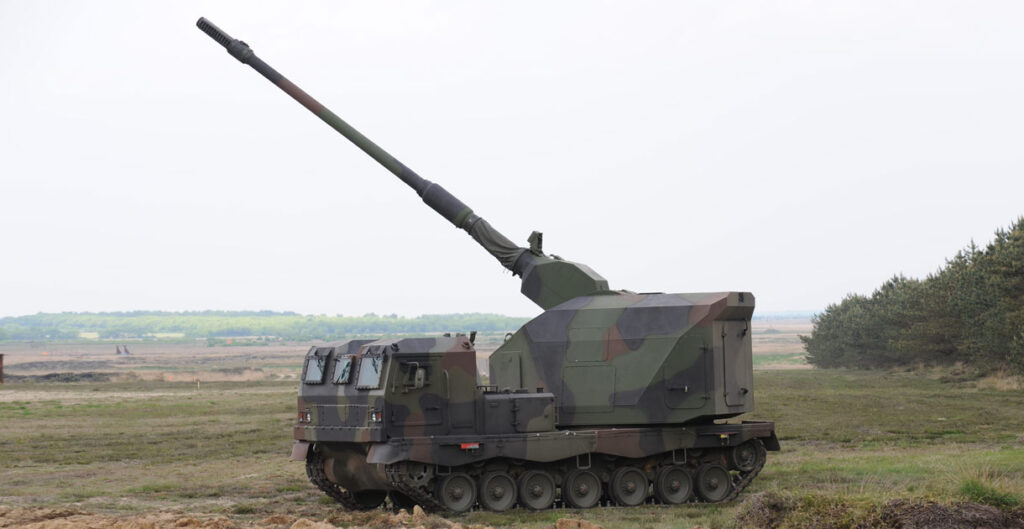
The Donar has a combat weight of 36 metric tons and is fitted with a MTU 8V 199 TE20 engine providing an output of 720 hp (540 kW). It can reach a top speed of more than 60 kilometres per hour when traveling on road and can travel more than a 500 kilometres distance on internal fuel only. The vehicle is 10.3 metres long when the gun is facing forward, 2.99 metres wide and 3.2 metres tall. At only 31.5 metric tons unladen, the Donar is air-transportable via an A400M or similar aircraft. Its hull is made from welded steel armor to protect against heavy machine gun fire, whereas underbelly armor protects the Donar against anti-personnel and (probably only smaller) anti-tank mines. The vehicle includes an NBC protection system as well as a climate control and air conditioning system for the crew’s cabin and the interior of the AGM turret.
The systems architecture of the Donar is designed to provide growth potential by allowing the addition of further sensors, a remotely operated weapon station (RWS) or new software functionalities such as remotely firing and remotely operating the Donar.
The Donar was tested by the German Army in the late 2000s, though it is understood that it was not trialed as part of a procurement tender or with any intent of purchase; instead tests were conducted to provide KMW with hypothetical customer feedback and to ensure maturity and reliability when used under simulated combat conditions. To this date the Donar has not attracted any sales.
Other variants
Aside of the tracked Donar and the later Boxer RCH 155, KMW has also showcased and offered a number of other variants of a mobile version of the AGM. Several truck-mounted variants of the AGM have been showcased either as 3D renderings, scale models or as photoshopped images.

Currently KMW advertises a truck-based variant in form of the AGM Iveco 8×8. Such a vehicle is expected to weigh up to 39 tonnes and have a crew of two or three. The frontal cabin is fitted with steel add-on armor, while its glass windows are replaced with bullet-proof glass counterparts. The AGM Iveco 8×8 can be fitted with an optional RWS or an independent optic for the commander, and features a climate control/air-conditioning system. As the truck-based AGM remains at a concept stage and KMW is open for the discussion of features and the selection of the base platform, no exact specifications are available.

The company also has showcased an artist’s impression featuring Navistar 6×6 truck fitted with the Artillery Gun Module. In this case the vehicle is equipped with the shorter 155 mm L/39 barrel, potentially due to the higher weight and stronger recoil associated with the longer gun barrel; it might be too much to handle for the lighter 6×6 truck. Unlike the tracked Donar and the wheeled Boxer RCH 155, all truck-based vehicles carrying KMW’s Artillery Gun Module need to deploy stabilizers before firing.
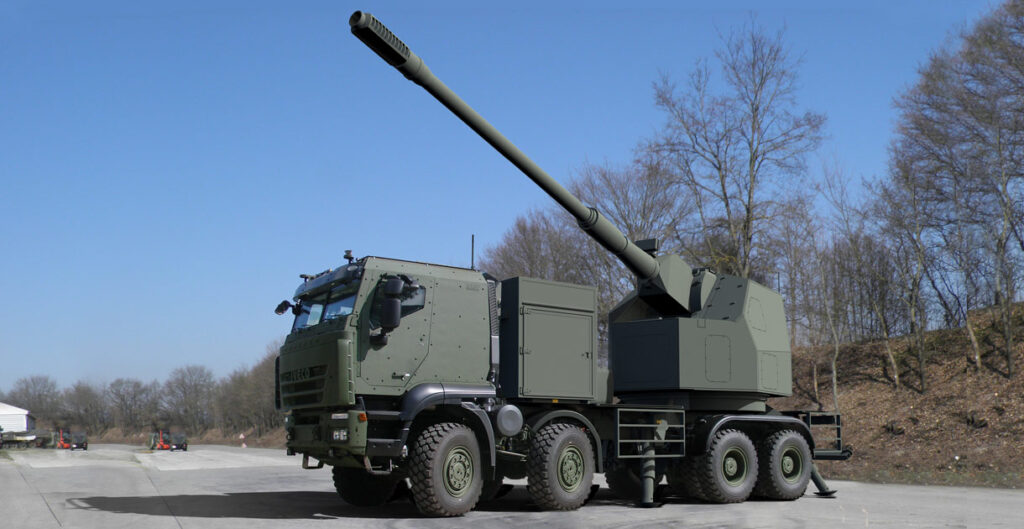
A truck-based variant of the AGM was downselected (alongside a version of the Elbit Systems ATMOS self-propelled gun) for the future artillery program of the Israel Defence Forces (IDF) in 2012. However due to various circumstances – which might be the indirect or direct result of corruption – the AGM was not tested and not seriously considered, despite being a cheap – and likely more capable – solution when compared to ATMOS. According to the Times Of Israel, the Israeli MoD converted the tender to a no-bid contract in favor of the Israeli company Elbit Systems.
A comptroller of the Israeli government found that amongst other things, the Israeli MoD canceled an essential live-firing demonstration of the AGM without stating a reason; apparently against the wishes of both KMW and the IDF’s Ground Forces, and used an incorrect unit price for its cost-effectiveness calculations. Instead of using the price quoted by KMW or requesting an updated price estimate, the Israeli MoD used the unit price of another version of the AGM – potentially the Donar or the Boxer RCH 155 – that had been quoted to another potential customer.
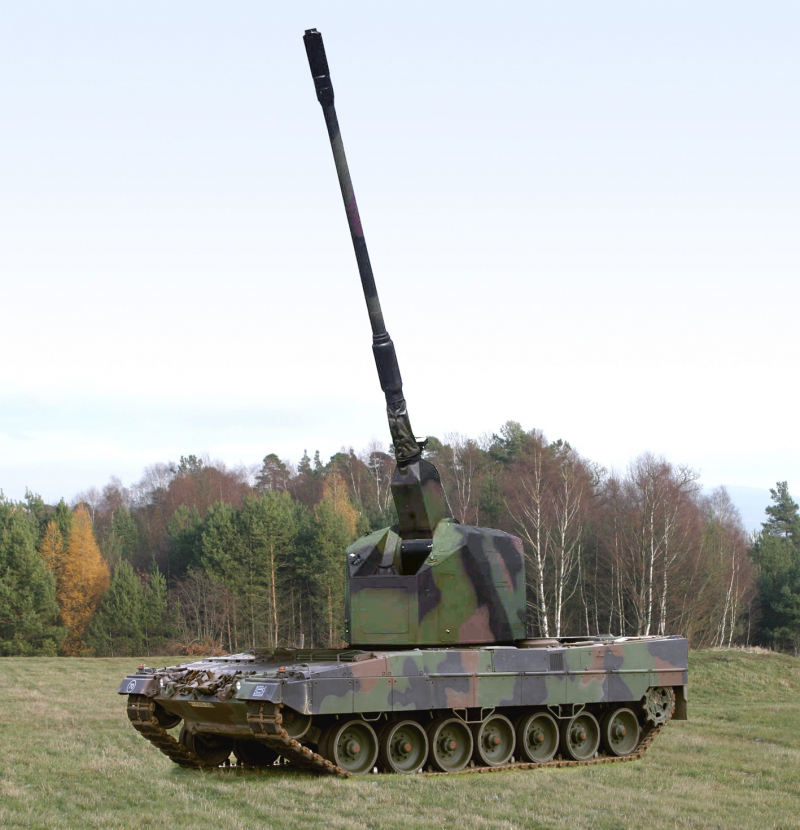
Before that there were supposedly concerns about Germany’s willingness to sell the AGM to Israel as the IDF continues to use cluster bombs (which are banned in 123 states including Germany) – or KMW’s willingness to allow the usage of such cluster munitions with the AGM. Subsequently KMW was then invited by the IDF to demonstrate the AGM to a live audience in Israel, including the ability to fire cluster munitions. This demonstration was canceled for no apparent reason. In addition to that, the Israeli MoD decided that the new SPG could not be dependent on foreign suppliers/states, a request that was not shared by the IDF itself.
Another concept shown by Krauss-Maffei Wegmann features a Leopard 2 main battle tank (MBT) hull fitted with the AGM in place of the tank’s original turret. This concept provides questionable value, as the vehicle will reach a weight comparable to the Panzerhaubitze 2000, while having a lower ammunition capacity, higher fuel consumption and a less optimized armor layout for the role.
The Boxer RCH 155
The Boxer RCH 155 was first presented at Eurosatory 2014 and has a crew of two. The Boxer RCH 155 is a slightly modified drive module fitted with a new mission module, which consists of a small extension of the driver’s compartment – providing space for the commander – and a large turret ring onto which the Artillery Gun Module is mounted. Like the Donar SPG, the Boxer RCH 155 was evaluated and qualified by the German Army.
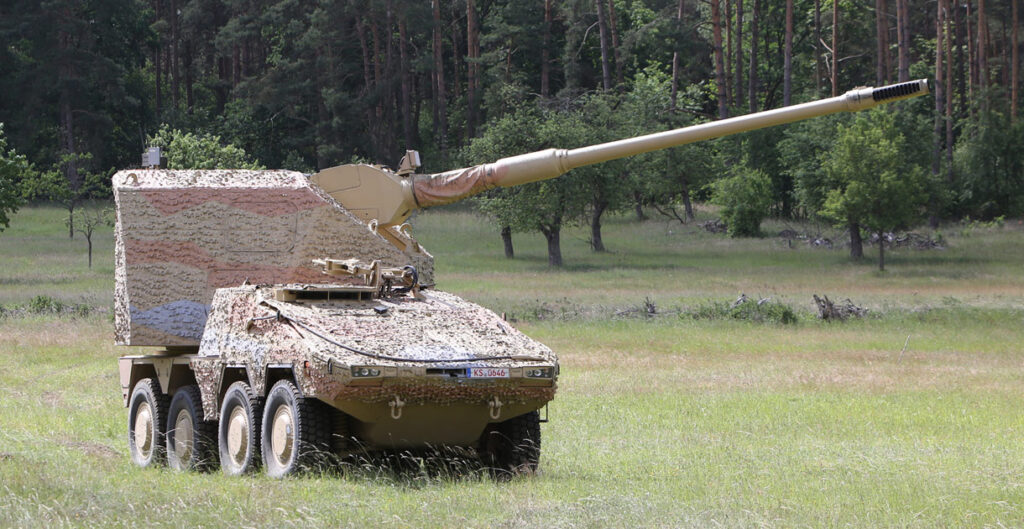
The Boxer RCH 155 is armed with a Rheinmetall-made 155 mm L/52 smoothbore gun; firing standard DM121 boat tail ammunition with six of the modular propellant charge modules, this gun has an effective range of 30 kilometres. In theory the current German ammunition does not fully utilize the 359 MPa pressure limit of the weapon; Rheinmetall has proposed using higher pressure ammunition (the so called “Top Charge”) to boost the muzzle velocity from 945 m/s to 1,003 m/s. This greater velocity results in an increased effective range of 35 kilometres. Using Rheinmetall Denel Munitions M1711 base-bleed round, the effective range can be increased to 40 kilometres and 47 kilometres (when using the Top Charge propellant). The M2005 V-LAP can further increase the effective range to ca. 63 kilometres when fired with the Top Charge propellant.
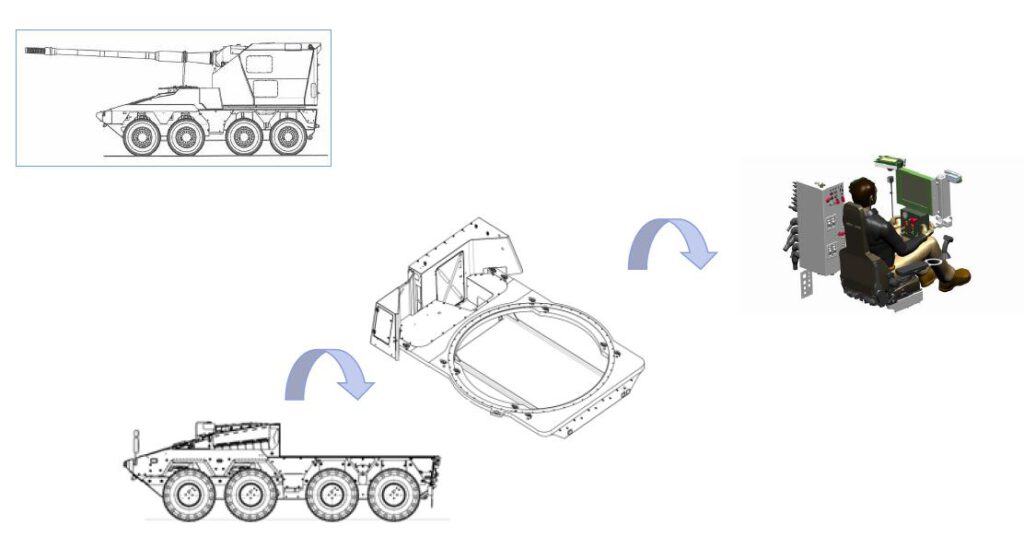
For achieving an even longer effective range, Diehl and Leonardo have developed the Vulcano Guided Long-Range (GLR) round with GPS guidance. This is a sub-caliber round with guidance kit and fins, which sacrifies a significant amount of HE payload to maximize the effective range. The 155 mm version of the Vulcano GLR is stated to have a maximum range of more than 70 kilometres. KMW is also working on integrating/qualifying NAMMO’s future 155 mm HE-ExR round with the Boxer RCH 155 and Panzerhaubitze 2000. This type of munition is still in development, but NAMMO aims to reach an effective combat range of up to 150 kilometres. As specialized anti-armor round, the Boxer RCH 155 could utilize the DM 702 SMArt (Suchzündermuniiton Artillerie) 155 round, which contains two self-targetting sub-munitions with EFP warheads capable of penetrating the vulnerable roof armor of APCs, IFVs and main battle tanks.
The Boxer RCH 155 is optimized for shoot-and-scoot tactics to avoid counter-battery fire. ARTEC states in its advertising materials that a fire mission with the Boxer SPG variant takes about 90 seconds between halting and the vehicle leaving. Of these 90 seconds, circa 20 seconds are spend on preparing for the fire mission – i.e. unlocking the gun barrel from the travel lock, elevating the barrel, rotating the turret into the desired direction, etc.; sixty seconds can be spent on firing up to nine 155 mm artillery shells; the remaining ten seconds are required for lowering the gun barrel, locking it and driving off.
ARTEC and KMW advertise the Boxer RCH 155 based on the latest Boxer A2 drive module, though the exact choice of engine – either the MTU 8V 199 TE20 engine or its slightly more powerful TE21 version – is up to the final customer. The latter provides an increased output of 600 kW (816 hp). It has a gross vehicle weight (GVW) of 38.5 metric tons, therefore it has to be fitted with the 415/80R685 XForce 2 or XForce ZL tyres from Michelin. On road the Boxer RCH 155 is expected to reach speeds above 100 kilometres per hour and travel distances of up to 700 kilometres before needing to refuel. It can climb 60% gradients and drive on 30% side slopes. The vehicle can cross trenches 2 metres wide and climb 80 centimetres high walls. Thanks to skid steering, the turning radius of the latest Boxer models is just 7.5 metres. The Boxer has 500 millimetres of ground clearance.
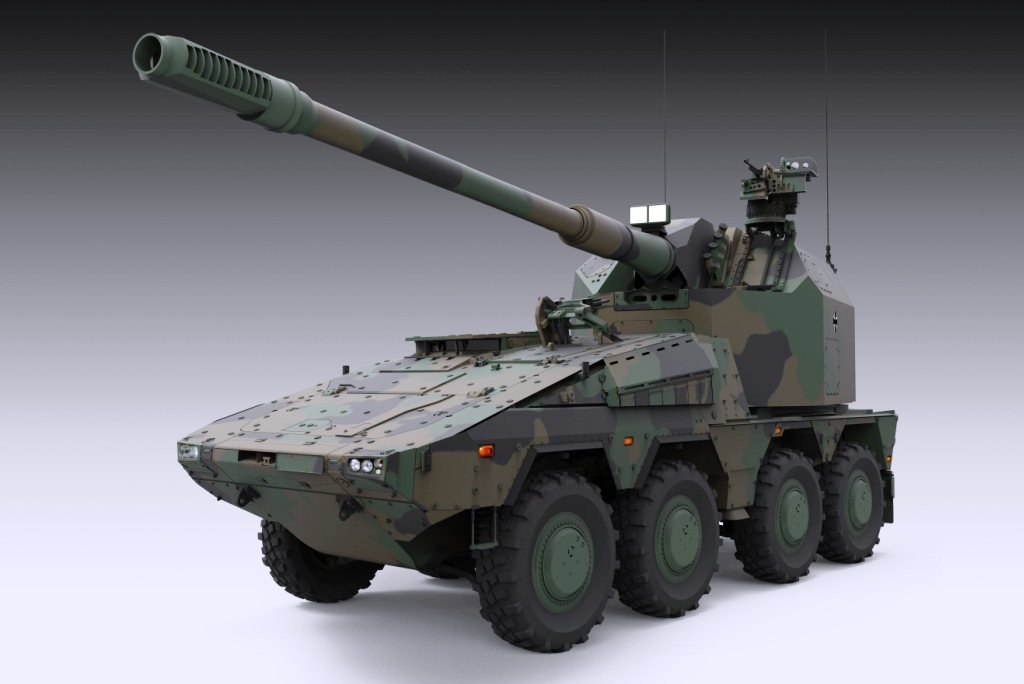
Recently a more refined version of the Boxer RCH 155 has been showcased, which is currently being tested by KMW in cooperation with the German military. According to the European Defence Review magazine, it is fitted with a new turret – internally known as LRIP 01 (Low Rate Initial Production) by KMW – which incorporates fully redesigned electronics and a number of design changes to meet the current requirements set by the German Army for a new wheeled self-propelled howitzer. Like the previous Boxer RCH 155 version, the improved variant with LRIP 01 turret does not require additional stabilizers when firing its gun. According to statements from an advisor of KMW, the company claims that the stress encountered on the suspension when firing the 155 mm L/52 gun is not higher than that encountered when driving off-road at higher speeds. Even when conducting MRSI fire missions, the Boxer RCH 155 doesn’t need further support to deal with the recoil.
Thanks to its enhanced electronics, the latest version of Krauss-Maffei Wegmann’s Boxer RCH 155 features an unique capability for self-propelled guns: it can fire accurately while being on the move. It demonstrated this capability in August 2021 to a live audience, accurately hitting a target nine kilometers away while slowly driving. The low speed was the result of the firing range’s control not permitting faster movement when firing. No other currently existing SPG currently has proven to be capable of also fireing while on the move, aside the much shorter ranged Patria NEMO system – but NEMO is a mortar system and hence serves in a different role. Thanks to being able to fire accurately on the move, the Boxer RCH 155 can evade counter-battery fire by changing position before being detected by counter-battery radar systems, which has a positive impact on survivability. Videos showing the Boxer RCH 155 firing while on the move can be found in the coverage of the recent Boxer trials by Soldat und Technik as well as Hardthöhenkurier.
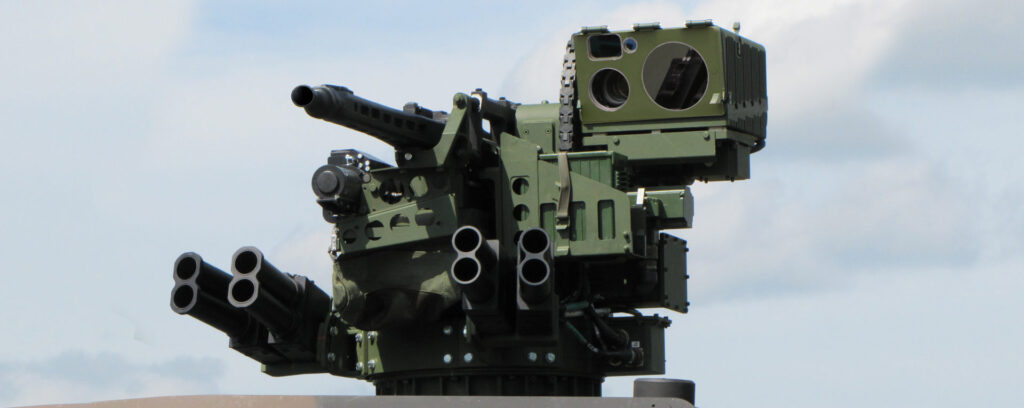
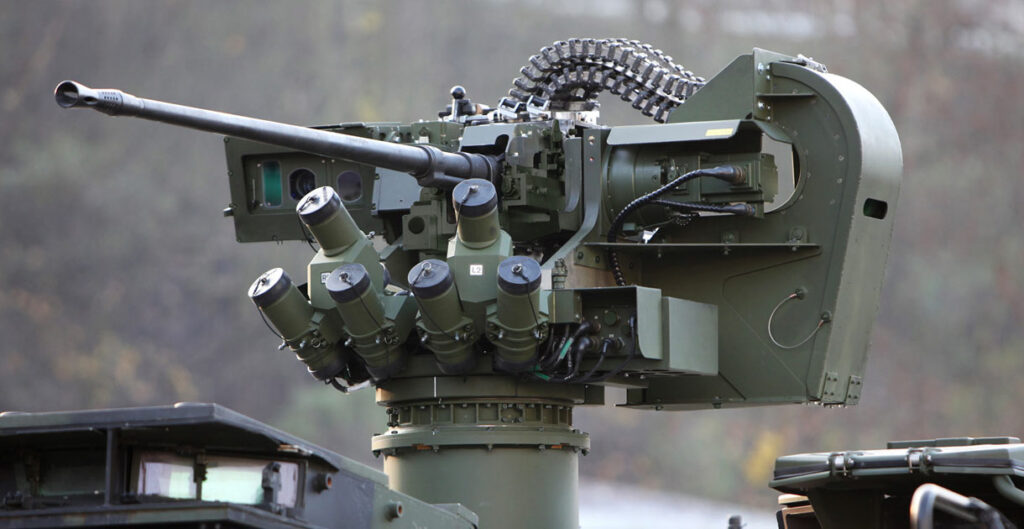
Compared to the earlier iteration of the Boxer RCH 155, the new LRIP 01 turret has a ca. 30 cm lower profile, which was required for the vehicle to stay within the loading gauges for railway transport. A FLW 100 RWS has been added ontop of the turret, providing the vehicle with improved self-defense capabilities while also acting as independent sight for the vehicle commander. While Wehrtechnik.info describes the RWS as FLW 200, photographs from KMW’s presentation of the system show the vehicle featuring a FLW 100 instead. It can be identified by the fact, that the sensor unit is mounted on the left side of the RWS; on the FLW 200 the sensor unit is mounted on the right side instead.
The FLW 100 can be fitted with a LAZ (Lafetten Abhängiges Zielfernrohr) 200 or LAZ 400 sensor unit. The LAZ 200 features an uncooled thermal imager with a native FOV of 8.7° and a resolution of 1,024 x 768. According to Rheinmetall, its manufacturer, the LAZ 200 can detect NATO standardized targets at a range of up to 8,700 metres and identify them at 1,700 metres distance. The LAZ 400 meanwhile features a more powerful cooled SAPHIR 2.6 MWIR thermal imager with a native FOV of 2.75° and a sensor resolution of 640 x 512. This offers an improved detection range of over 14,000 metres and an identification range of up to 3,000 metres. Both the LAZ 200 and LAZ 400 also feature CCD daylight cameras and laser rangefinders. Based on photographs from the event, the LAZ 200 sight is currently used on the Boxer RCH 155.
The FLW 100 can be fitted with a 5.56 mm MG4 light machine gun or a 7.62 mm MG3 machine gun (or a similar weapon such as the FN MAG or the newer MG5 machine gun from Heckler & Koch). Unlike the heavier FLW 200, it cannot be armed with a 12.7 mm M2 heavy machine gun or a 40 mm Heckler & Koch GMW automatic grenade launcher. Aside of being used for self-defence, the FLW 100 can be used for hunter-killer operations as showcased by KMW during a live-fire demonstration. Apparently the RWS has been integrated into the Boxer RCH 155’s fire control system and hence acts as force-multiplier during (the rare) direct firing at enemy targets.

On the Boxer RCH 155, the FLW 100 RWS is mounted in a quite unique fashion; rather than being fixed on the turret roof, the whole RWS and base platform is mounted on the left side of the turret roof on rails. This allows the FLW 100 to be moved forward along the turret front, so that it can be placed next to the 155 mm L/52 barrel into travel position. With the remotely operated weapon station in travel position, the Boxer RCH 155 remains in the railroad loading gauge, which otherwise would be exceeded. It is understood that the FLW 100 cannot be used in travel position, although KMW has not confirmed this yet.

The Wegmann 76 mm smoke grenade discharging system has been added to the Artillery Gun Module turret of the Boxer RCH 155. Two banks of four smoke grenade dischargers each are installed next to the gun mantlet. They can be used to conceal the position of the Boxer RCH 155 once the vehicle has been spotted, allowing the Boxer RCH 155 to retreat under the cover of multi-spectral smoke clouds.
In order to increase the situational awarness of the commander and driver, additional sensors have been mounted along the Boxer hull. According to Wehrtechnik.info, the sensors in questions are part of Hensoldt’s SETAS (See-Through Armour System). SETAS is a NGVA compatible solution consisting of multiple sensor modules containing daylight cameras and uncooled thermal imagers for up to an 360° azimuth coverage. The software of the SETAS is capable of stitching the individual outputs together in real time, moving target indiciation and object tracking. It also supports sensor fusion of the daylight and thermal channels. According to data from Hensoldt, the SETAS allows the detection of persons at night up to a 450 metres distance and up to a 900 metres distance during daytime. Against military vehicles, the detection ranges should be significantly higher. The system has a typical power consumption of 750 watts and one kilowatt at peak load.
Based on photographs the new variant of the Boxer RCH 155 also features a new roof hatch for the commander, providing an alternative way of entry and exit. The vehicle has been presented clad in SAAB Barracuda Mobile Camouflage System (MCS), which reduces the vehicle’s signature in the visual, the near-infrared and the thermal spectrums. It also reduces the radar reflection of the vehicle and provides internal heat reduction when operating in hotter climates by acting as an insulation. According to the manfacturer, a side benefit of using the Barracuda MCS is a reduction in fuel consumption by up to 25% when operating in hot terrain, as the air-conditioning system doesn’t have to run at maximum capacity at all times.

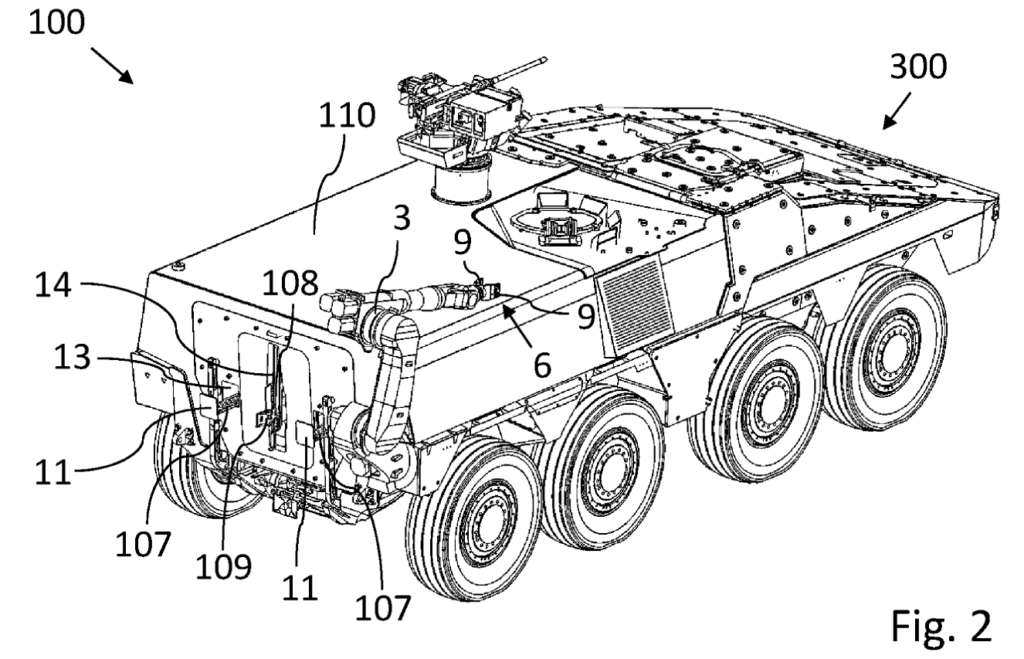
Krauss-Maffei Wegmann is working on an automated Boxer ammunition resupply mission module, which allows restocking the Boxer RCH 155’s autoloader without requiring any personnel to exit their respective vehicles. The mission module features a large storage bay in the rear, which based on patent drawings has enough space for at least 38 compatible 155 mm artillery shells as well and a large amount of propellant charge modules (believed to be either 220 or 242, depending on the exact geometry of the storage system). The mission module also contains a new commander’s position with a roof hatch, four vision blocks and a FLW 200 remotely operated weapon station for self-defence.
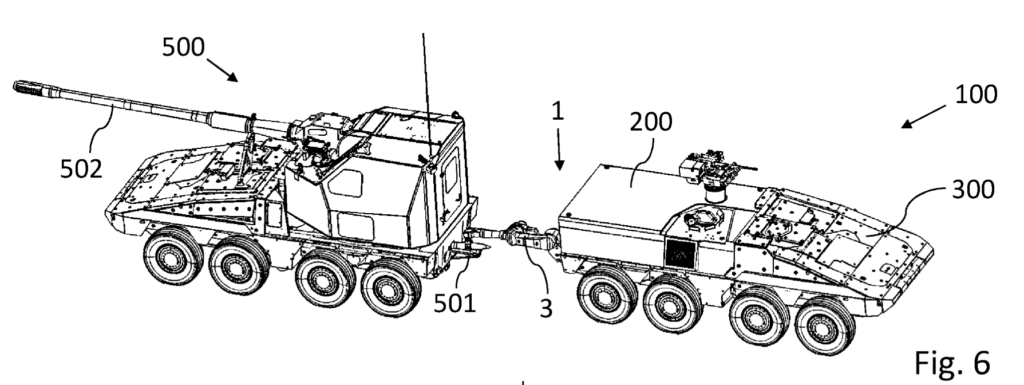
While other ammunition resupply vehicles such as the American M992 Field Artillery Ammunition Support Vehicle and the South Korean K10 utilize conveyor-based systems to transfer ammunition to their respective SPG counterparts, KMW’s new Boxer module will seemingly rely on a more complex solution: at the rear side to the right of the ammunition loading/unloading hatch, an articulated robot is located. It appears to be roughly similiar to those commonly used in the automotive industry. This robotic arm is used transfer both the projectiles and the propellant modules from the ammunition resupply vehicle to the Boxer RCH 155. It is unlikely that it can match the speed and simplicity of a conveyor-based system.
Germany’s future artillery programm
KMW’s improved variant of the Boxer RCH 155 with the LRIP 01 turret is aimed at the German Army’s current requirement for a wheeled SPG, which is meant as supplement to the existing Panzerhaubitze 2000 tracked SPG. According to the presentation held by Colonel Jürgen Schmidt, the Director of the Combat Directorate of the BAAINBw, at the Future Artillery 2021 conference, the intent of the Bundeswehr is to purchase 120 new wheeled self-propelled gun systems with autonomous turret. The new wheeled SPG has to meet more than 100 requirements, some of which were are “kill criterias”, while other are “shall requirements” or “must requirements”. In addition to that, circa 30 new (wheeled) rocket launcher systems with increased range and 100 new wheeled mortar systems (believed to be based either on the latest Fuchs 1A9 configuration or the Boxer AFV) as replacement of the current 120 mm Tampella mortar are to be procured. The new SPG will be purchased following an open tender with the German Army’s industrial partners. It is to be based on an existing wheeled platform already in service with the military in order to ease logistics and reduce unit costs. The crew is to be reduced from the five crew members found in a current Panzerhaubitze 2000 to either two or three men. For a 24 hours battlefield day, a second set of crew members could be assigned to each SPG. There are apparently two different designs expected to compete for the contract; a slide in Colonel Schmidt’s presentation featured the Boxer RCH 155 from KMW and a Rheinmetall MAN Military Vehicles (RMMV) 10×10 HX3 truck fitted with a new autonomous artillery turret as examples of industry proposals.
Rheinmetall’s solution is newer – and less mature – than the Boxer RCH 155. The HX3 truck series was first revealed in May 2021 and has yet to enter service. While the truck platform is believed to be as reliable and cost-effective as previous generation of Rheinmetall MAN trucks, its Artillery Truck Interface (ATI) and the mounted weapon system are understood to be completely new solutions. Coincidentally Rheinmetall’s reveal video appears to not show the turret firing; instead the barrel seems to be digitally shaken and flames/smoke are apparently added via CGI.

The new wheeled SPG based on the 10×10 version of the HX3 truck is fitted with an armored cabin for driver and commander. Large windscreens and side windows provide the two-men crew with good situational awareness. No additional optical sensors (cameras or thermal imagers) appear to be mounted alongside the cabin. The HX3-based artillery system also lacks an RWS, hence its self-defence capability is lower, as it lacks both the direct firepower of the RWS and the ability to use the RWS as independent optic in hunter-killer operations for direct firing.
The gun can be fired along the whole 360° azimuth, but for firing the gun the HX3-based gun system has to employ stabilizers; hence Rheinmetall’s SPG cannot fire while on the move and has reduced shoot-and-scoot capabilities compared to the Boxer RCH 155. On the other hand Rheinmetall’s solution provides a significantly larger ammunition stowage (for 40 rounds of 155 mm ammunition and an unspecified amount of propellant charges) and is fitted with a more powerful gun: Rheinmetall is proposing the use of its new 155 mm L/60 gun, which the company also offers for the currently on-going Panzerhaubitze 2000 Nutzungsdauerverlängerung (lifetime extension) project. This gun featues a 9.33 metres long barrel, adding an additional 1.27 metres in barrel length over its 155 mm L/52 predecessor. Furthermore the new gun has an enlarged chamber volume of 29 litres and is made of newer steel alloys capable of handling pressures up to ca. 500 MPa. This allows the 155 mm L/60 gun to fire boat tail ammunition at targets in up to 48 kilometres distance, base-bleed ammunition at targets in up to 64 kilometres distance and V-LAP ammunition at targets in up to 83 kilometres distance. According to Krauss-Maffei Wegmann, the Boxer RCH 155 could also deal with the increased recoil of this weapon system – or a 155 mm L/58 or L/62 barrel.
Rheinmetall has not released official details regarding protection level and weight of the system, but it is understood to be significantlly less protected than the Boxer. The company claims that the artillery version of the HX3 truck offers five metric tons of growth potential, suggesting a potential combat weight of 45 metric tons.
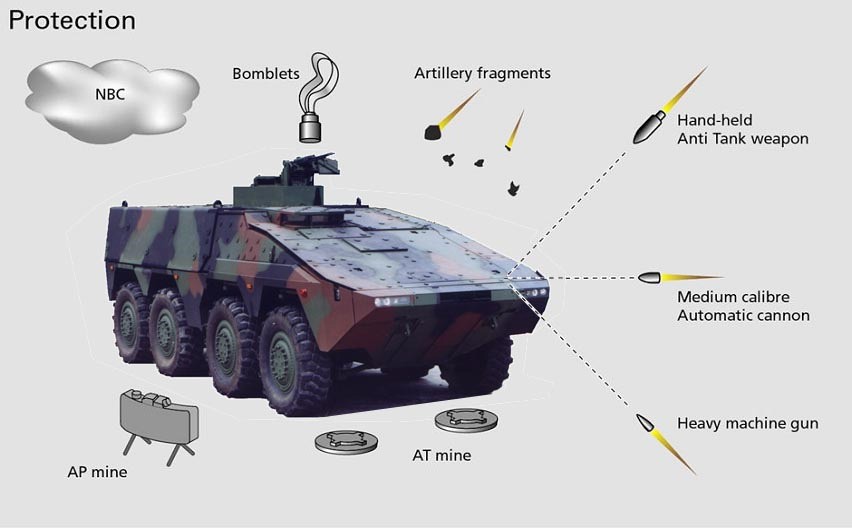
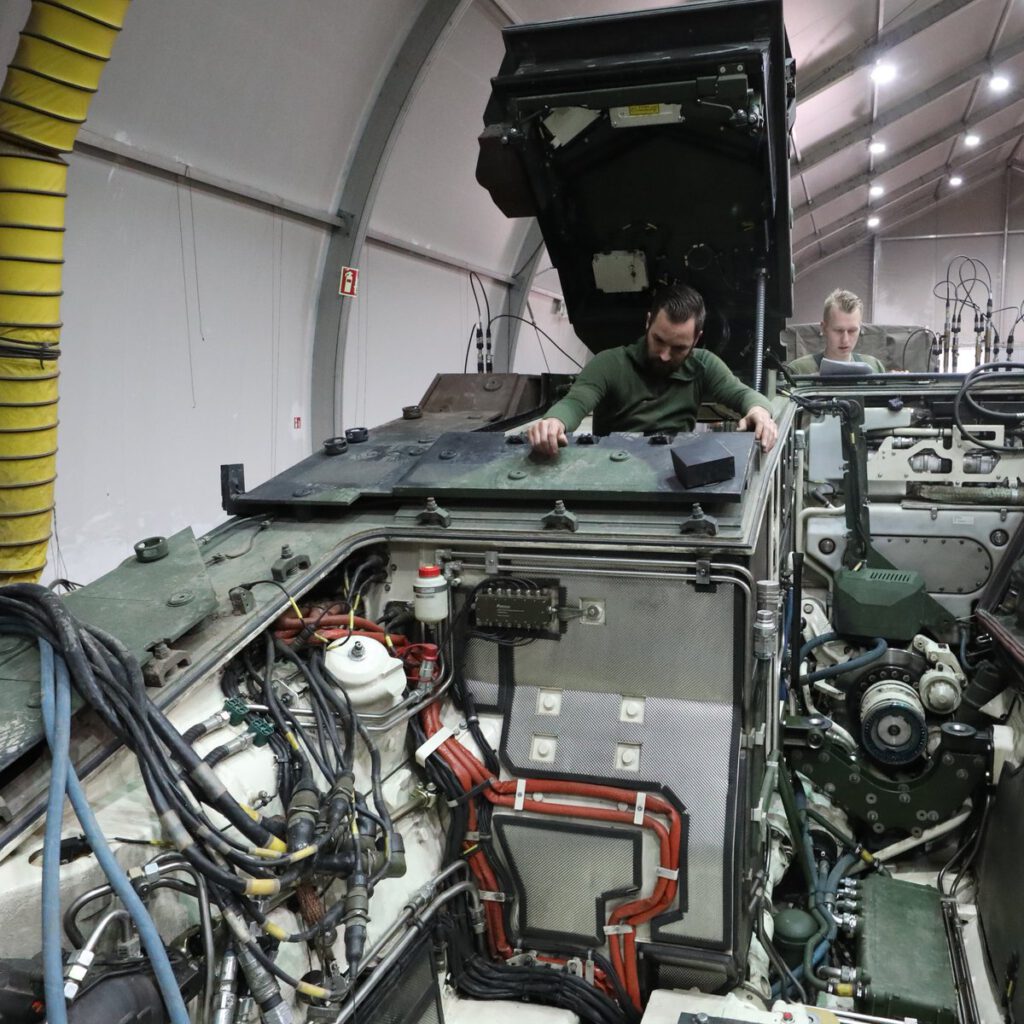
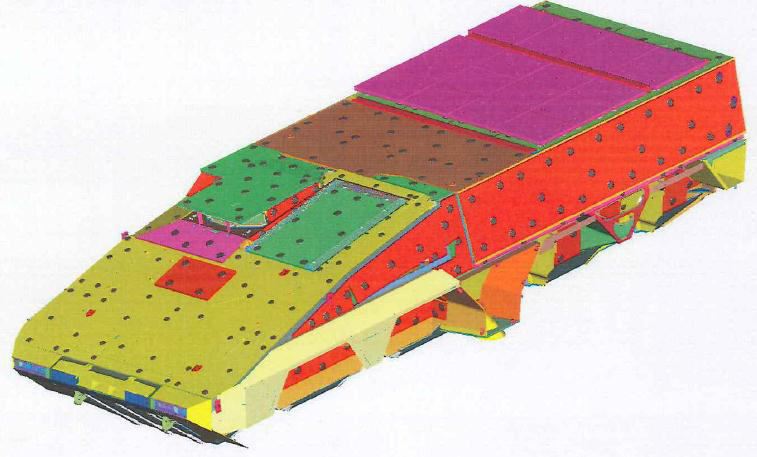

The Boxer RCH 155 offers a higher level of ballistic and mine protection than Rheinmetall’s offering; it is fitted with ballistic protection modules belonging to the AMAP (Advanced Modular Armor Protection) product family made by IBD Deisenroth (nowadays Rheinmetall Protection Systems) and a mine protection kit made by GEKE Schutztechnik. The ballistic protection consists of a mix of spaced high hardness steel armor and composite ceramic add-on armor modules, allowing the Boxer drive module to reach STANAG 4569 Level 4 ballistic protection; i.e. its armor provides protection against 14.5 mm AP rounds fired from 200 metres distance along the whole azimuth. According to ARTEC, the sloped hull front can stop the same round even when hit from elevated positions that would negate the slope. Directly from the front the Boxer is understood to be protected against the Soviet-designed 30 x 165 mm 3UBR6 armor-piercing ammunition.

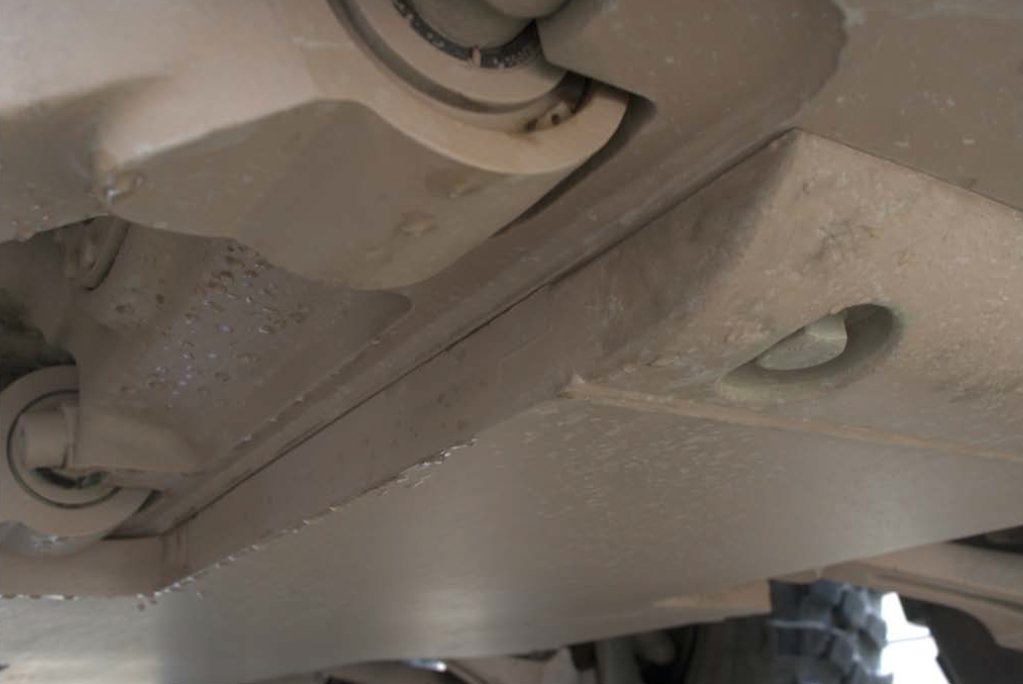
The multi-layered floor plate of the Boxer’s drive module is capable of withstanding 10 kilograms of TNT detonating under the wheels or the hull. Sufficient space between the different floor plates is provided to prevent the bulging of the outer ones to tear the interior’s floor open. Spall-liners and decoupled seats further improve the survivability in case of an attack. An additional belly armor plate was developed for Germany’s Afghanistan deployment as part of ISAF, which protects against mines and IEDs utilizing explosively formed penetrators (EFPs). It was adopted on the improved Boxer A1 and follow-up models including the Boxer RCH 155.
According to KMW, its high level of protection results in the Boxer RCH 155 being more cost-effective than truck-based artillery systems, as its higher protection level means that it can operate closer to the frontline – hence it can fire more accurately (needing less ammunition for a given fire mission) or can use more powerful rounds (e.g. boat tail ammunition instead of base-bleed or V-LAP rounds). The company states that the ammunition in the Artillery Gun Module is protected to the same level as the crew, suggesting that some other parts of the turret might offer less protection. Compared to the Panzerhaubitze 2000, the Boxer RCH 155 currently lacks the option to mount add-on roof armor against top-attack threats such as artillery fragments, bomblets and sensor-fuzed munitions.
| Vehicle | Panzerhauzbitze 2000 | AGM Donar | Boxer RCH 155 | Rheinmetall MAN HX3 |
| Weight | 55.8 tonnes 57.66 tonnes (up-armored) | 36 tonnes | 38.5 tonnes | ca. 45 tonnes (est.) |
| Armament | 155 mm L/52 gun with 23 litre chamber | 155 mm L/52 gun with 23 litre chamber | 155 mm L/52 gun with 23 litre chamber | 155 mm L/60 gun with 29 litre chamber |
| Ammo load | 60 rounds of 155 mm ammo with 288 propellant modules | 30 rounds of 155 mm ammo with 144 propellant modules | 30 rounds of 155 mm ammo with 144 propellant modules | 40 rounds of 155 mm ammo |
| Engine | MTU 881 Ka-500 V8 engine 1,000 hp | MTU 8V199 TE20 720 hp | MTU 8V199 TE20/TE21 up to 816 hp | MAN D26 up to 510 hp |

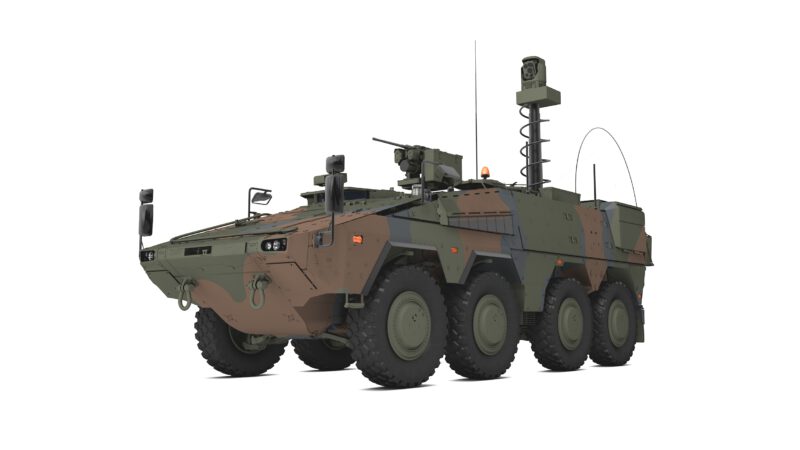
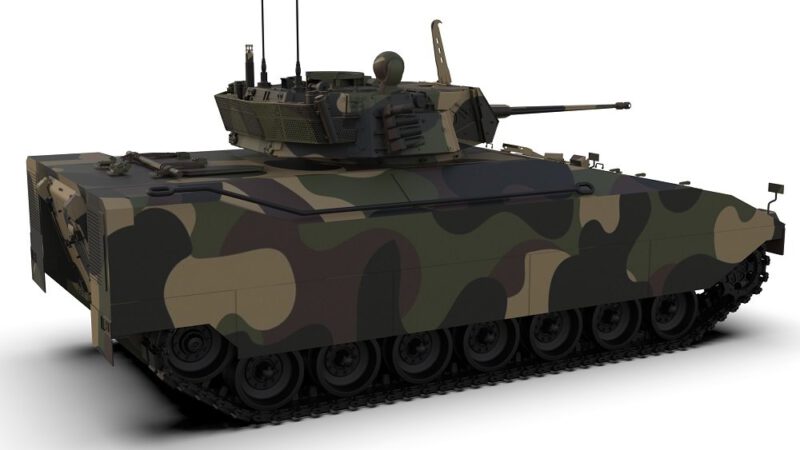
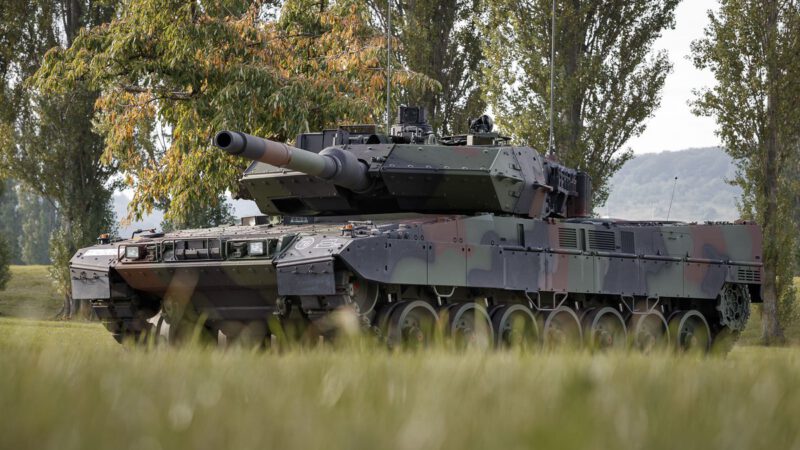

Just a thought from a Canadian; Ukraine needs a 1000+ tanks of the grade of Leopard A7+V with training or better, the South Korean Black Pather looks good too with excellent power to weight ratio (Leopards need same the ratios with the same range). Ukraine needs a 1000+ missiles with training capable of hitting central Russia and all it’s oil and gas fields, Aluminum mines and all military air bases. Ukraine needs 10,000+ suicide drones from the US. Russian and their Putin style leaders like to bluster and are largely full of sh*t. If the Russian nuclear missiles fly, then they fly, tell Russia directly you are not going to be held hostage by them or any other despot! It is just too bad Ukraine and the other Former Soviet countries did not keep some to point at the morons in Moscow, maybe the need some to keep the assholes at bay? It is also too bad Bush 1, without warning, did not nuke the Tora Bora cave complex with a multi war head hydrogen bombs from a single Trident missile from a Ohio Class submarine likely on patrol in the Indian Ocean at the time after 9/11 before Bin Laden escaped to Pakistan, then no 20+ plus year war for nothing? Germany, Canada, USA, UK and the rest of the EU need “suck it up” a go all in and give all that Ukraine wants and needs or have another 20 year war with despots? The aforementioned philosophy should apply to Tiwaian as well. It is East vs West, or more accurately asshole vs non asshole states, countries or non state actors and criminals. Example: China is a asshole country, so the non asshole countries must help them for free, for Tiwaian Semiconductor to set up satellite areas in Europe, USA and Canada for the foundry production of semiconductors under Tiwaian diplomatic control. The One China Policy means One Mandarin Policy of repression. Germany needs to get off the fence and stop worrying about how Moscow perceives things or what they may do now or in the future. If Turkey is nasty to Sweden about the Kurds they are protecting from the despot Erdoğan, the Kurds just need to come to Canada on a expedited bases then the despot has nothing to complain about Sweden joining NATO. I am of the option that Turkey needs the boot from NATO for being a virtual dictator.
P.S. As a military/mechanical/science enthusiast I love your stuff.
The Boxer RCH155 Idea is nice, but for example for German militäry useless. You ask why?
Because of 38,5t weight, which are shown in the report, Boxer APC have 36,5 battle weight to fit in A400M as long distance transport for international missions, in the announced German medium force all troops must fit in an A400M and i dont see a transport solution of RCH155 in several coils (each max 36,5t) which gets combat ready on 1 Boxer within 20-30min preparation time.
Hello. This is a great website. However, you keep on using images posted on Twitter by me that belong to me without permission or acknowledgement. Could you please either credit me or remove them. Thank you.